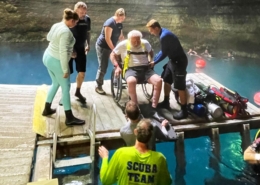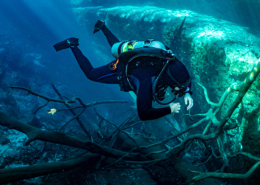Scubility: Because Scuba Diving is for Everyone
By Kate Heller
Whether you call it disabled diving, handicapped scuba or, as SDI does, Scubility, adaptive diving programs all carry the same message: Diving is for everyone. If you are just thinking about getting into diving and on the fence about it, ask others why they dive. One of the reasons you may hear is that these individuals consider it their own version of water therapy. Water adds a feeling of weightlessness.
In a past article, I wrote about my experience working with veterans and kids who need to adapt to the world around them. SDI Scubility adapts to their needs. Wheelchair-bound, paraplegic, quadriplegic — it doesn’t matter. Diving is still possible.
One of the goals many of us had when becoming instructors was to do something meaningful. Something that brought people happiness and even relief, when they thought they’d never have that.
A buddy and I had the opportunity to achieve that goal by taking the Scubility Instructor course. We had experience in the past working with individuals who wanted to dive but needed assistance. Going through this course was something neither of us will forget.
Practical exercises were a huge component of this course
Each exercise challenged us to not only explain certain concepts clearly and precisely but to rethink the way we deliver information to students. One of the scenarios had us explaining to a blind student how to put a scuba unit together. In the end, we all talked about what we noticed and like about what someone else did. One of the realizations that we had was that generic words such as this, here, and that were hard for a blind student — or, really, any student — to follow.
Being able to explain scuba unit assembly is something instructors, assistant instructors, and divemasters can do easily…if able to talk. Our next challenge, however, was explaining how to assemble a scuba unit to a student who was hearing impaired. This taught us the importance of emphasizing and explaining through demonstration.
We had to be more aware of the way we demonstrated skills, making our hand movements sufficiently apparent so that no step of the process would be missed. All of us were able to take something away from these vision- and hearing-impaired exercises. They helped us to become great instructors no matter what kind of students we have in the future.
Challenges and learning experiences kept coming at the pool
Each of us took turns playing the role of student. It was generally a different type of student each time. The starting exercises gave us a sense of what it was like being a paraplegic or quadriplegic. This involved figuring out how to get students to the pool’s edge carefully and safely.
In the quadriplegic exercise, we also learned how to help get students into their gear. This proved to be difficult as it required the four of us to work together. We learned quickly that hands needed to be on the student at all times to prevent tipping both out of and in the water.
The last in-water exercises were full of new information and things to think about. We partnered up and took a blind diver on a dive in the pool. Before descending we had to go over the hand signals that we would use to communicate.
We used the “joystick” tactic. Here the student would hold his hand in a thumbs-up position. The guide would then use the student’s thumb to communicate. Pushing the thumb forward, backward, left and right were the directional signs. Pulling up or down on the thumb meant ascent and descent. For equalizing we used taps on the nose.
For other skills we also used taps. Taps on the mask would indicate partial or full flood and clear while pulling gently on the mask meant to remove and replace. Taps on the regulator meant either remove replace the regulator or regulator recovery.
We ended with leading a student who was a quadriplegic around the pool
Just as we had in the other exercises, we learned a lot about how we as buddies and instructors need to be aware and work with students. For example, if you were the person focusing on the student’s face for signs of enjoyment/distress, you had to decide on facial signs. These would indicate the need to clear ears, clear masks, okay, not okay, etc. Our team used a combination or head tilts and blinking to communicate.
Other team members helped with other parts of the dive. The person on the student’s left had to control their buoyancy. In that role, I learned that watching the student’s buoyancy as well as mine was a bit difficult at first. Aside from focusing on the student, we as a team also had to stay in communication as well. This was true were one of us were to have a problem or if we noticed something that another did not.
Rewarding and eye-opening are the two ways I describe the Scubility instructor course. It taught us more about being thorough and fluid with our skill explanations. It also taught us the patience and creativity we needed to teach at this level.
In the past, I’ve worked with kids and veterans who needed assistance when diving. Thanks to the Scubility instructor course, I feel more confident in my abilities now. If anything, I’m more excited and motivated to teach scuba and help those who think that diving isn’t for them. Scuba is a “come one, come all, come as you are” sport can adapt to almost any diver’s needs.










Leave a Reply
Want to join the discussion?Feel free to contribute!